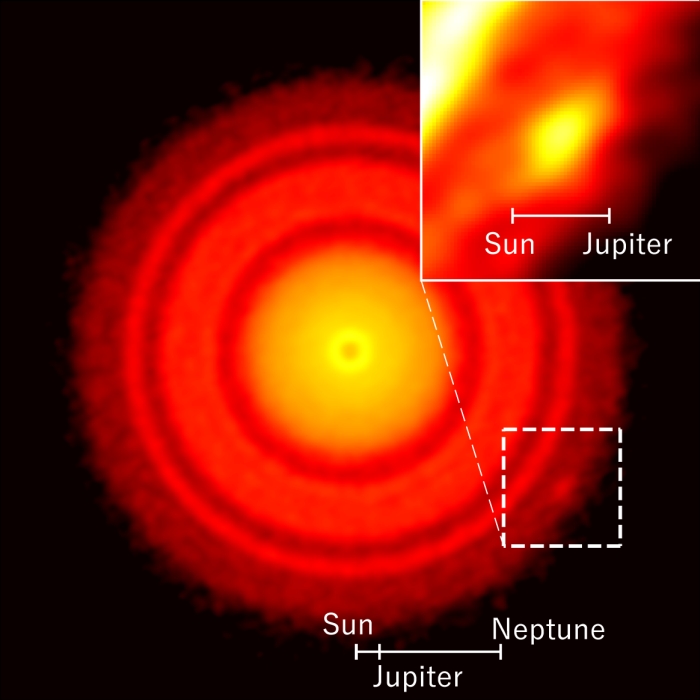Around a young star not far from Earth, a broad disc of dust swirls. This is the stuff that planets are made of - and astronomers think a huge clump spotted and photographed in the outer edge of the disc is in the early stages of becoming one.
If they're right, this will mark the first time the precise location of planetary accretion has been identified.
This planetary formation is happening near the closest young star to Earth, TW Hydrae - just 194 light-years away. Even better, the TW Hydrae system is thought to look very similar to how our Solar System looked when it was just a baby - which means it could provide a wealth of insight into how our own planets once formed.
The dust clump is quite large, spanning a distance similar to that between the Sun and Jupiter's orbit, and astronomers aren't yet completely certain that it is a planetary seed.
"The true nature of the clump is still not clear," said astronomer Takashi Tsukagoshi of the National Astronomical Observatory of Japan.
"It could be a 'circumplanetary' disc feeding a Neptune-sized infant planet. Or it might be that swirling gas is raking up the dust particles."
Just check out the scale of this image:
 (ALMA (ESO/NAOJ/NRAO), Tsukagoshi et al.)
(ALMA (ESO/NAOJ/NRAO), Tsukagoshi et al.)
We don't have a precise rundown of how planets are born, but observational evidence to date suggests the process starts with a bunch of stuff sticking together through electrostatic forces, until it has enough mass to gravitationally attract larger and larger pieces from the protoplanetary disc - the stuff left over from star formation.
Just as the matter that swirled into the star formed an accretion disc, so too should the matter that swirls into newly forming planets. That's what Tsukagoshi means by a circumplanetary disc, and finding one would help us understand the final stages of planetary formation.
But the star's protoplanetary disc of dust and gas is cold, which means it's hard to see in wavelengths such as optical and infrared, and although it can be imaged in radio wavelengths, details can be difficult to make out.
The Atacama Large Millimetre/submillimetre Array (ALMA) in Chile, an array of radio telescopes specifically designed to study light emissions from some of the coldest objects in the Universe, has made great strides here, imaging a plethora of protoplanetary discs.
We usually infer the presence of planet formation in these discs based on large gaps - the result of something called orbital clearing, which occurs when a planet passes through and gravitationally hoovers up everything in its path. This can be seen on a smaller scale performed by the tiny moons between Saturn's rings.
To date, only a small handful of newly formed planets have been directly imaged in a protoplanetary disc, and never before (that we know of) have we seen one with a disc of its own.
Actually, we still might not have, because the clump may turn out to be something else. There are characteristics that don't exactly match our predictions of circumplanetary discs, such as its brightness and overall shape.
The discrepancies mean it could be what is known as a gas vortex, which form in the hydrodynamic flows of the outer regions of a protoplanetary disc. These have been theoretically proposed as nurseries for the formation of planetesimals, so they're still worth watching - it's just not quite the same phenomenon.
But finding just a single clump, as opposed to several, doesn't quite match predictions either, so the astronomers have more work to do.
"Although we do not have a robust conclusion, pinpointing the exact place of planet formation is highly valuable to us," Tsukagoshi said.
"Next we'll obtain even higher resolution ALMA images to reveal the temperature distribution in the clump to look for hints of a planet inside. Also we plan to observe it with the Subaru Telescope in infrared to see if there is hot gas around a potential planet."
The research has been published in The Astrophysical Journal Letters.
#Space | https://sciencespies.com/space/this-massive-clump-of-dust-could-be-an-early-planet-and-the-scale-is-mind-blowingly-huge/
No comments:
Post a Comment